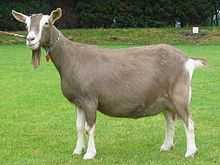Toggenburg (goat)


The Toggenburg, nicknamed Togg, is a breed of milk goat, named after the region in Switzerland where the breed originated, the Toggenburg valley in the Canton of St. Gallen. It is considered the oldest registered breed.
History
There are over 300 goat breeds worldwide and the Toggenburg is considered the oldest breed that was registered (in the 1600s) and that distinction includes the United States.[1]
Characteristics
Toggenburgs are medium in size, moderate in production, and have relatively low butterfat content (2-4%) in their milk. Toggenburgs possess a general Swiss Marked pattern with various dilutions. The color is solid varying from light fawn to dark chocolate, with no preference for any shade. Distinct white markings are as follows: white ears with dark spot in middle; two white stripes down the face from above each eye to the muzzle; hind legs white from hocks to hooves; forelegs white from knees downward with a dark line (band) below knee acceptable; a white triangle on either side of the tail. Wattles, small rudimentary nubs of skin located on each side of the neck, are often present in this breed. The face may be straight or dished but will not have what is referred to as the Roman nose.[2]
Toggenburgs should have straight or dished faces, but never roman noses. Toggenburgs are generally a friendly, quiet and gentle breed, and are good as pets, although they are classed as dairy goats. They are often extremely curious and inquisitive animals. Toggenburgs are arguably the hardiest of all goat breeds; crosses with meat goats (i.e. Kalahari red, Boer goats) can add better growth rates to their offspring, offering a milking line to the offspring of meat goats.[3]
Breeds
In 2006, in Switzerland where the breed was officially recognized in 1892, there were 850 goats in the Toggenburg Valley and the Werdenberg region of 3000 in Switzerland, which is down from 20,000 in the 1950s. The club St. Gallen Goat Breeders Association, that was founded in 1901, registers the breed. The Verein Ziegenfreunde was formed to protect the breed and unite breed owners.[4]
The Toggenburg breed underwent a development program when introduced to Britain; the resulting British Toggenburgs are heavier and have improved milk quality. By the middle of 2002, 4146 Toggenburgs had been registered with the New Zealand Dairy Goat Breeders Association,[5]
See also
References
- ↑ "Dairy breeds". Retrieved December 14, 2014.
- ↑ "American Dairy Goat Association". ADA. Retrieved December 14, 2014.
- ↑ "Breeds registered". Retrieved December 14, 2014.
- ↑ "Slow Food Presidia". Retrieved December 14, 2014.
- ↑ "New Zealand Dairy Goat Breeders Association". Retrieved December 14, 2014.
| ||||||